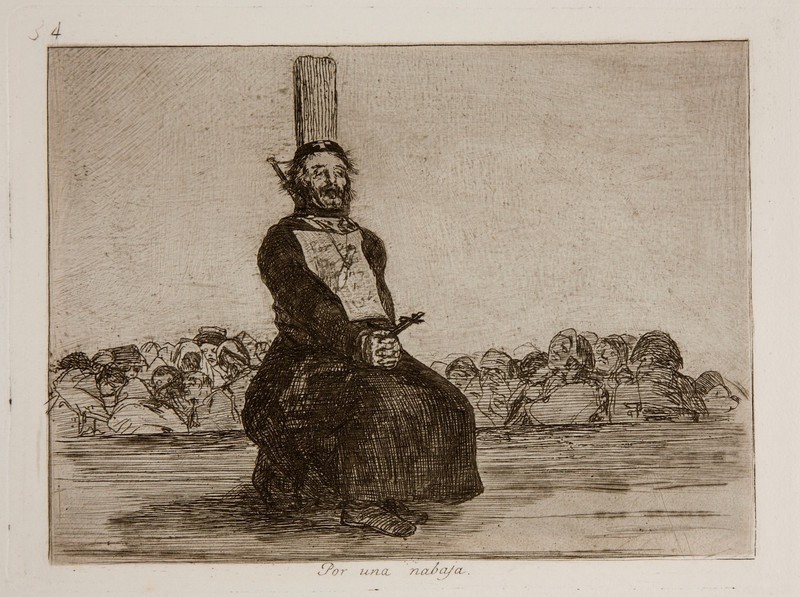- Cronología
- Ca. 1812 - 1815
- Dimensiones
- 157 x 208 mm
- Técnica y soporte
- Aguafuerte, aguatinta, punta seca y bruñidor
- Reconocimiento de la autoría de Goya
- Undisputed work
- Ficha: realización/revisión
- 08 Dec 2010 / 05 Jun 2023
- Inventario
- 225
See Sad presentiments of what must come to pass (Tristes presentimientos de lo que ha de acontecer).
The title was handwritten on the print by Goya in the first and only series that is known to have been printed at the time the works were created, which the artist gave to his friend Agustín Ceán Bermúdez. Therefore, the title was etched into the plate at a later date and left unchanged as of the first edition of the Disasters of War printed by the San Fernando Royal Academy of Fine Arts in Madrid in 1863, after the printing of the series in the possession of Ceán Bermúdez.
There are no surviving preparatory drawings for this print.
From 19 October 1809, Joseph Bonaparte (Corte, 1768 - Florence, 1844) adopted the garrotte as the main method of execution in Spain. Generally, this practice was used to make an example of someone, serving to maintain order and warn the population of the possible consequences of any subversive act. The newspaper Diario de Madrid references more than 40 using the garrotte between 1810 and 1812.
In December 1808 it was decided that all inhabitants of Madrid who were found to be in possession of a weapon would be arrested and condemned to death. Those condemned for carrying a weapon were forced to wear that weapon around their neck, as well as a text explaining the precise circumstances in which they had been arrested.
This is exactly what Goya depicts in this print: the moment in which a man who has been discovered in possession of a knife is executed by garrotte. On his chest he bears the knife hanging from a cord and, below that, a text that recounts the circumstances leading to his arrest. His hands are clasped around a crucifix. The scene takes place in a public place before a crowd attending the execution. In contrast to the events shown in print no. 29, He deserved it (Lo merecia), this crowd expresses distress and distaste, perhaps in solidarity with the death of a fellow Spaniard.
Goya has painstakingly depicted the face of the executed man, who is open-mouthed, his eyes staring into the distance. His hair stands on end, revealing the pain he has suffered before his death. It is a hard, realistic vision of the death penalty that leaves the viewer in no doubt as to the repulsion and disapproval that the artist feels towards this form of punishment, while the brief title On account of a knife is employed to suggest its disproportionate nature.
Goya also deals with this theme in The garrotted man (El agarrotado) and takes it up again in other prints in this series such as the following one, no. 35, One can't tell why (No se puede saber por qué) which depicts a mass execution.
La plancha se conserva en la Calcografía Nacional (cat. 285).
-
Exhibition of Spanish Art, Including pictures, Drawings and Engravings by GoyaBurlington Fine Arts ClubLondon1928cat. 57
-
De grafiek van GoyaRijksmuseum RijksprentenkabinetAmsterdam1970from November 13th 1970 to January 17th 1971cat. 75
-
Goya. Das Zeitalter der Revolucionen. Kunst um 1800 (1980 – 1981)Hamburger KunsthalleHamburg1980cat. 240
-
Goya and the espirit of enlightmentThe Metropolitan Museum of ArtNew York1989scientific directors Alfonso E. Pérez Sánchez and Eleanor A. Sayre. From May 9th to July 16th 1989. Exhibited also in the Boston Museum of Fine Arts, from January 18th to March 26th 1989cat. 87
-
Francisco de Goya: Maleri, Tegning, GrafikkNasjonalgallerietOslo1996from 10th to April 14th 1996cat. 168
-
Francisco de GoyaMuseo d'Arte ModernaLugano1996exhibition celebrated from September 22nd to November 17th.cat. 34
-
Francisco Goya. Sein leben im spiegel der graphik. Fuendetodos 1746-1828 Bordeaux. 1746-1996Galerie KornfeldBern1996from November 21st 1996 to January 1997cat. 120
-
Francisco Goya. Capricci, follie e disastri della guerraSan Donato Milanese2000Opere grafiche della Fondazione Antonio Mazzottacat. 114
-
Goya. Opera graficaPinacoteca del Castello di San GiorgioLegnano2006exhibition celebrated from December 16th 2006 to April 1st 2007p. 69
-
Goya en tiempos de guerraMuseo Nacional del PradoMadrid2008consultant editor Manuela B. Mena Marqués, from April 14th to July 13th 2008cat. 95
-
Goya et la modernitéPinacothèque de ParisParís2013from October 11st 2013 to March 16th 2014cat. 73
-
Goya, grabadorMadridBlass S.A.1918cat. 136
-
Goya engravings and lithographs, vol. I y II.OxfordBruno Cassirer1964cat. 154
-
Vie et ouvre de Francisco de GoyaParísOffice du livre1970cat. 1049
-
Catálogo de las estampas de Goya en la Biblioteca NacionalMadridMinisterio de Educación y Cultura, Biblioteca Nacional1996cat. 238
-
ParísPinacoteca de París2013p. 136
-
Goya. In the Norton Simon MuseumPasadenaNorton Simon Museum2016pp. 114-151
